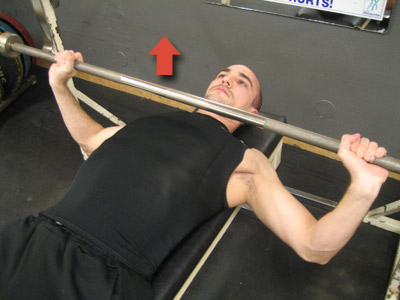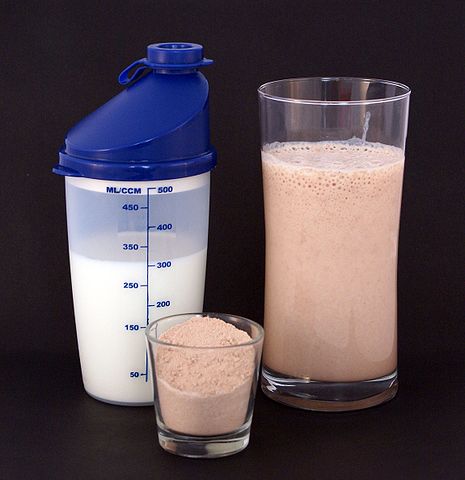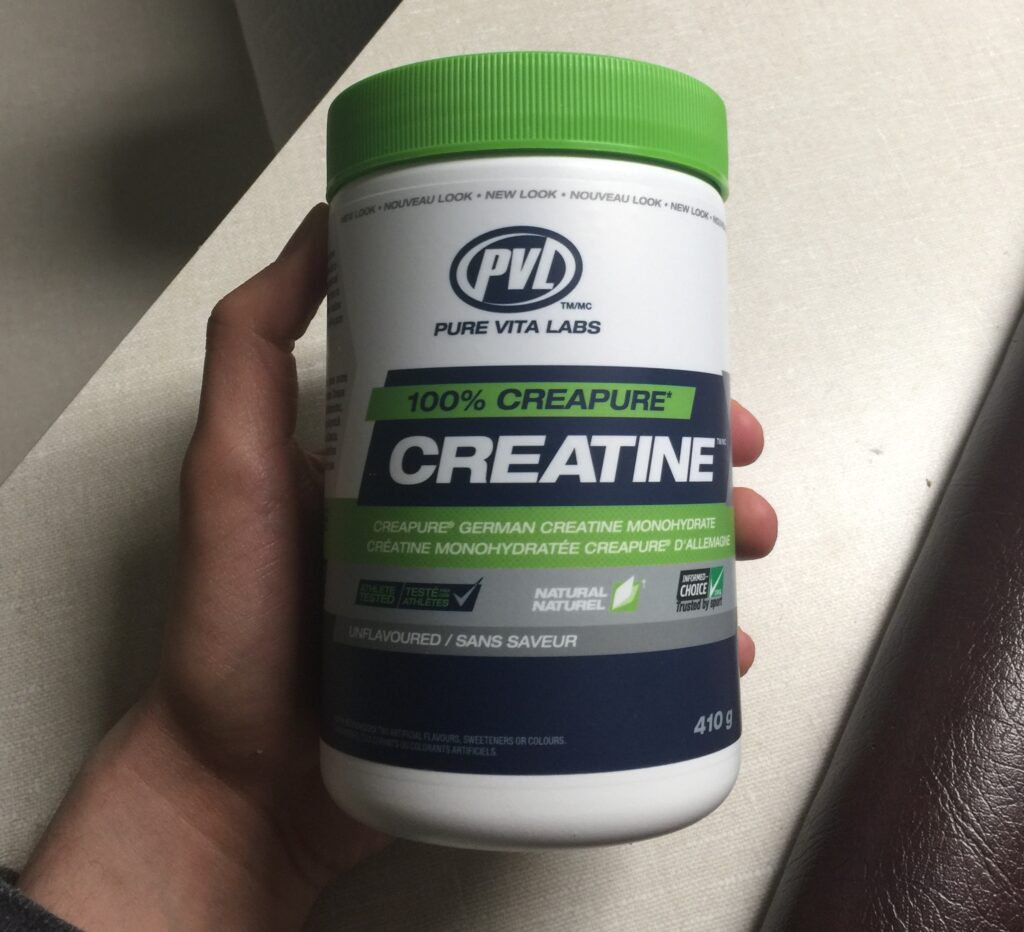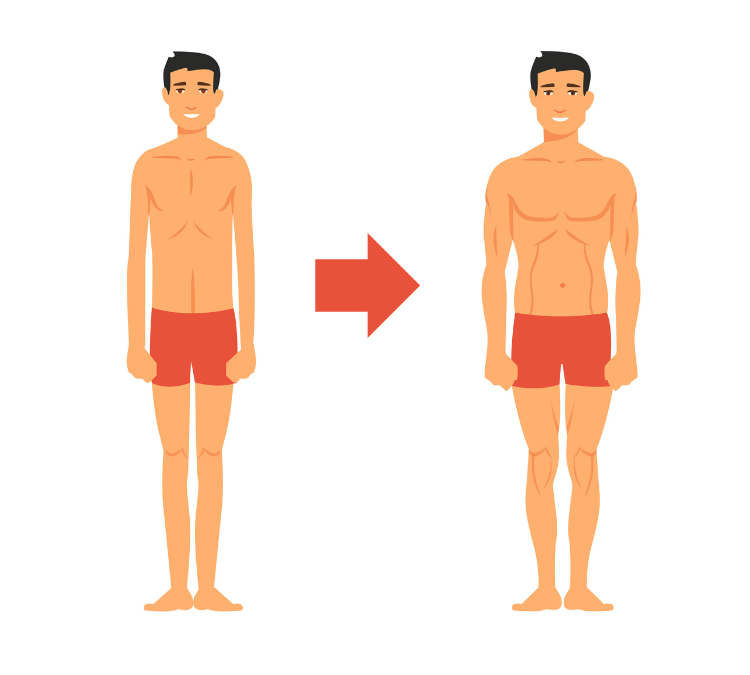Are you a skinny guy struggling to bulk up and build muscle? You’re not alone.
Many skinny guys face unique challenges when trying to gain weight and muscle mass. It can be very frustrating when you try everything, like working out and eating a ton of food, but still not see the results that you want to see.
I get it, because I’ve been there. And so have a lot of my clients.
The good news is you can do it, and I’ll show you how with this comprehensive guide on how to bulk up as a skinny guy. We’ll cover everything from calorie surplus, macronutrient balance, training techniques, and diet strategies to help you finally achieve the muscle gains you’ve always wanted.
We’ll dive deep into the world of bulking, providing you with the knowledge and tools necessary to transform your body and reach your goals. Say goodbye to your skinny days, because it’s time to embark on a muscle-building journey that will change your life.
Key Takeaways
Consume a calorie surplus of nutrient-dense foods and calculate your TDEE to maximize muscle growth.
Achieve the right macronutrient balance with protein, complex carbohydrates, and healthy fats for successful bulking.
Incorporate effective training techniques such as compound exercises, progressive overload and rest & recovery into your routine for optimal gains!
The Importance of Calorie Surplus

Maintaining a calorie surplus is a key factor in successfully bulking up and gaining muscle mass.
Why?
Because a calorie surplus provides the energy needed for muscle growth and weight gain as a skinny guy. Fuel your muscles and support their growth by consuming more calories than your body requires to maintain its current weight.
However, simply consuming more calories is not enough. You need to ensure that you are getting your calories from nutritious, calorie-dense foods like:
nuts and nut butters
avocados
cheese
whole milk
eggs
olive oil
oily fish
full-fat Greek yogurt
meats
whole wheat bread
rice
pasta
fruits and vegetables
These are just a handful of foods that will help keep your body strong and healthy.
But how many calories should you aim for? That depends on your Total Daily Energy Expenditure (TDEE). Here’s how:
Calculate Your Caloric Needs
Accurate calculation of your daily caloric needs is a necessary step towards maximizing your muscle growth.
A TDEE calculator is an incredibly useful tool for this purpose. It considers factors like:
age
gender
height
weight
activity level
To give you an accurate assessment of your daily caloric needs, it’s essential to consider your body weight.
Once you have calculated your TDEE, aim for a surplus of 300-500 calories to support muscle growth. This will ensure that you are gaining weight at an ideal rate of approximately one pound per week for maximum results. To make sure you are gaining weight during bulking, you should adjust your caloric intake as needed.
A good resource for the TDEE calculator is at https://tdeecalculator.net/
Consistency in Eating Habits
When aiming to bulk up and gain weight, maintaining consistent eating habits is vital.
By regularly consuming a calorie surplus through multiple meals and snacks throughout the day, even when not hungry, you’ll increase your chances of reaching your bulking goals.
To achieve a calorie surplus, strive to consume:
Three hearty, balanced meals each day
Two nutrient-dense snacks each day (think nuts, protein shakes, etc.)
Challenge yourself to eat every 2-3 hours, if you can
Push yourself to eat even when not hungry. This can be tough in the beginning, but if you’re working out (we’ll talk about this below), your appetite should make it easier to eat more
Macronutrient Balance for Bulking

For effective bulking, it’s important to strike a balance among your macronutrients, namely protein, carbohydrates, and fats.
Each macronutrient plays a vital role in supporting muscle growth, with protein being a key nutrient for building and strengthening muscles. Carbohydrates should be the main part of your calorie intake (around 60%) for optimum bulking results.
In the following subsections, I’ll delve deeper into the importance of each macronutrient and provide guidelines on how to optimize your protein intake, carbohydrate consumption, and healthy fat intake for maximum muscle growth.
Protein Intake
Given that protein is fundamental for muscle growth and repair, ensuring an adequate intake in your diet is going to be crucial.
To maximize your muscle-building potential, aim for 1 g/lb (2.2 g/kg) of protein per day if you’re of healthy weight, active, and wish to build muscle. This translates to consuming the necessary grams of protein for your body weight.
So, let’s say you weigh 160 pounds. That’s about 160 grams of protein per day.
(Experienced lifters on a bulk require higher intakes of up to 1.50 g/lb (3.3 g/kg). This helps in keeping the fat gain to a minimal level. But if you’re still skinny and trying to bulk up, you won’t need this much protein).
Including lean meats, eggs, and dairy in your diet are great options for meeting your protein needs. Remember, consistency is key, so make sure to distribute your protein intake throughout the day to keep your muscles well-fed and growing.
Carbohydrate Consumption
Carbohydrates significantly contribute to fueling your workouts and replenishing muscle glycogen stores.
Focus on complex carbs like whole grains, fruits, and vegetables, which offer more sustained energy and nutrients than simple carbs.
Incorporating complex carbohydrates into your bulking diet can help you reach your goals more effectively. Some examples of complex carbs include:
Sweet potatoes
Oatmeal
Whole grain bread
Pasta and rice (whole wheat)
Complex carbs are also more nutrient-dense and have a gentler impact on blood sugar levels compared to simple carbs.
Healthy Fats
The production of hormones and overall health rely heavily on the consumption of healthy fats.
Why is this important?
Because it helps ensure maximum muscle growth and maintenance of optimal body fat levels. Aim for a daily intake of healthy fats between 20% and 30% of your total daily calorie intake.
Incorporate sources of healthy fats such as:
Avocados
Nuts
Seeds
Olive oil
Fish (or fish oil)
into your bulking diet to get the essential nutrients your body needs.
Remember, a balanced diet is key to supporting muscle growth, so don’t neglect the importance of healthy fats when you’re bulking.
Effective Training Techniques

To maximize muscle growth, you can’t ignore effective training techniques.
In this section, we will explore various training methods, such as compound exercises, progressive overload, and the importance of rest and recovery, that can help you build muscle effectively.
I will also delve into each training technique, offering insights on how to blend them into your workout routine for the best muscle growth.
Compound Exercises
Compound exercises are key to building muscle mass, as they target multiple muscle groups simultaneously. By focusing on these exercises, you’ll be able to stimulate more muscle growth than with isolation exercises alone.
Examples of compound exercises include:
squats
deadlifts
bench presses
military press
pull-ups and chin-ups
Incorporate these exercises into your workout routine to target multiple muscle groups and maximize your muscle-building potential.
Progressive Overload

Progressive overload is a fundamental training principle that involves gradually increasing weight, reps, or sets to continuously challenge your muscles and promote growth.
By implementing progressive overload in your training program, you’ll ensure that you are constantly progressing and maximizing your muscle growth potential.
To practice progressive overload in weight training, follow these steps:
Increase the weight or intensity by about 5-10% each week or every two weeks.
This gradual increase in load allows your body to adapt safely and prevents injury.
Remember to listen to your body and make adjustments as needed to avoid overtraining and maximize gains.
Rest and Recovery
Rest and recovery are essential for muscle growth and repair.
Allowing your muscles ample time to recover between training sessions helps prevent overtraining and maximizes your muscle-building potential.
Overtraining is a real problem that can actually slow down your muscle growth.
For maximum muscle growth, take a break of at least 48 hours between workouts targeting the same muscle group. So, if you workout your legs today, don’t do legs until at least 2 days have passed.
This ensures that your muscles have adequate time to repair and grow, setting you up for success in your bulking journey.
Sleep and Muscle Growth

Muscle growth and recovery significantly depend on lots of sleep.
During sleep, your body repairs and builds muscle tissue, making it a crucial component of your bulking journey. To support muscle growth and optimize your training efforts, aim for at least 7-9 hours of quality sleep per night.
Inadequate sleep can hinder muscle recovery and negatively impact your performance, so make sure to prioritize your rest and create a sleep environment that promotes relaxation and rejuvenation.
If you can sneak in a nap during the day, do it!
Diet Strategies for Skinny Guys

Having discussed calorie surplus, macronutrient balance, and training techniques, we will now explore various diet strategies that will enable skinny guys to consume sufficient calories for bulking.
These strategies will ensure that you’re fueling your body with the right nutrients, allowing you to build muscle and reach your goals more effectively.
I will provide insights on meal planning and preparation, liquid calories, and successful snacking to assist you in achieving your daily calorie goals and promoting muscle growth.
Let’s get to it:
Meal Planning and Preparation
I highly recommend you do this.
Planning and preparing meals and snacks in advance is a great way to ensure consistent calorie intake and avoid skipping meals.
By having nutritious, high-calorie snacks/meals readily available, you’ll be better equipped to reach your daily calorie goals and support muscle growth.
Some delicious and nutritious high-calorie meals and snacks for bulking include:
Protein bars
Jerky
Peanut butter toast
Cereal bars
Nuts
Fruit juice or smoothies
Protein shakes
Hardboiled eggs
Tuna
Stock your kitchen with these nutrient-dense foods and prepare your meals ahead of time to make it easier to reach your calorie surplus and bulk up effectively.
Liquid Calories

This one is like a cheat code, so don’t skip it!
Utilizing liquid calories, such as smoothies and shakes, can help you easily increase your calorie consumption. Liquid calories are often easier to consume than solid food, making them a convenient way to reach your calorie goals and support muscle growth.
Try incorporating shakes and smoothies into your diet, like this bulk up super smoothie recipe:
3 Tbsp peanut butter
500 ml whole milk
150g oats
2 bananas
2 scoops of protein powder
Supplements for Bulking
Alongside your diet and training regimen, supplements can offer additional support to your bulking endeavors.
While supplements should never replace a balanced diet and proper training, they can provide additional support in meeting your daily nutrient needs and maximizing muscle growth.
In the following subsections, we’ll explore two popular supplements for bulking: protein powders and creatine.
These are the only two supplements that I usually recommend to my clients. Everything else is just extra (except for maybe fish oil!).
I will discuss their benefits and provide guidelines on how to use them effectively in your muscle-building journey.
By the way, forget about mass gainer powders. You don’t actually need it.
Protein Powders

Protein powders can help you meet your daily protein requirements and support muscle growth.
They are an efficient and convenient way to ensure you’re getting enough protein to build and repair muscle tissue, especially if you struggle to consume enough protein through whole foods alone.
When choosing a protein powder, look for high-quality sources like whey, casein, or egg protein, and a low sugar and carb content.
I personally like whey protein isolate.
You can enjoy up to two protein powder-based drinks per day for maximum benefits.
Creatine

Creatine is a popular supplement that can enhance athletic performance and muscle growth.
It works by pushing extra water into your muscles, allowing you to lift heavier weights and promoting muscle growth through the natural hormone IGF-1.
However, before incorporating creatine into your supplement regimen, it’s essential to research potential downsides and consider your individual needs. Some potential side effects include:
Dehydration
Upset stomach
Muscle cramps
Weight gain
Bloating
Digestive issues
Always consult with a healthcare professional before adding new supplements to your routine.
Monitoring Your Progress

Keeping track of your progress is key to ensuring effective bulking.
By tracking your body composition, strength gains, and other performance metrics, you can make necessary adjustments to your diet and training plan to maximize your muscle growth potential.
In the following subsections, I’ll discuss how to measure your body composition to track muscle growth and provide guidelines on adjusting your diet and training based on your progress and goals.
Measuring Body Composition
Measuring body composition allows you to track muscle growth and adjust your diet and training accordingly. By regularly assessing your body composition, you’ll have a better understanding of your progress and can make informed decisions about your health and fitness goals.
Some tools and methods for measuring body composition at home include skinfold calipers or portable bodyfat measurement devices.
These methods can be expensive and/or a hassle to do, so a pretty good alternative is to use the Navy Seals Calculation Method to calculate your body fat percentage. All you need are a few body measurements (your weight, neck size, and belly size). It’s not as accurate, but when measuring progress, consistency is more important than accuracy. In other words, if you pick one method, stick to that method for the entire workout plan when you measure your progress.
Measure your body composition once every month in the same places to track your progress and observe the changes you’re making.
Adjusting Diet and Training
Many times, you’ll need to adjust your diet and training plan based on your progress.
This will help to maximize your bulking efforts.
Monitoring your progress can help you identify when changes are needed and ensure that you’re on track to reach your goals.
Some signs that it’s time to adjust your training program include:
Plateaus (not making any progress in your workouts)
Boredom
Lack of challenge
Persistent injuries or soreness
Lack of results
Be prepared to make changes to your diet and training routine as needed to achieve your bulking goals.
Common Mistakes to Avoid
Although bulking up is an exhilarating process, awareness of common pitfalls that can impede your progress is crucial.
Excessive cardio, inconsistent eating habits, and inadequate rest can all negatively impact your muscle growth and prevent you from reaching your goals.
By avoiding these common mistakes and following the guidelines provided in this guide, you’ll be well on your way to maximizing your bulking results and achieving the muscle gains you’ve always wanted.
Summary
In conclusion, bulking up as a skinny guy can be challenging, but with the right knowledge and strategies, you can achieve your muscle-building goals.
By maintaining a calorie surplus, balancing your macronutrients, implementing effective training techniques, and monitoring your progress, you’ll set yourself up for success in your bulking journey.
Remember, consistency and dedication are key to transforming your body and reaching your goals.
Oh and be sure to check out this post on how to know when to stop bulking.
Happy muscle building!
Frequently Asked Questions
How can a skinny guy bulk fast?
For a skinny guy to bulk up fast, weight training regularly, consuming plenty of calories from a balanced diet, and getting plenty of sleep are key. Additionally, focusing on compound exercises that work multiple muscle groups at once can help stimulate muscle growth and ensure maximum results.
What should skinny guys eat to gain muscle?
To gain muscle, skinny guys should focus on eating nutrient-dense foods that are high in calories and protein such as chicken, salmon, nuts, seeds, avocados, olive oil, Greek yogurt, milk, and beans. Additionally, weight training regularly and getting enough sleep will help ensure successful results.
What are some examples of compound exercises for muscle growth?
Squats, deadlifts, pull-ups, and bench presses are excellent compound exercises that can help maximize muscle growth.
How much protein should I consume daily to support muscle growth?
To support muscle growth, aim for at least 1g/lb (2.2 g/kg) of protein daily. For experienced lifters on a bulk, higher intakes of up to 1.50 g/lb (3.3 g/kg) are recommended. Reach your muscle-building goals by consuming the right amount of protein!
What is the optimal sleep duration for muscle growth and recovery?
Optimizing your muscle growth and recovery requires at least 7-9 hours of quality sleep per night.


Recent Comments